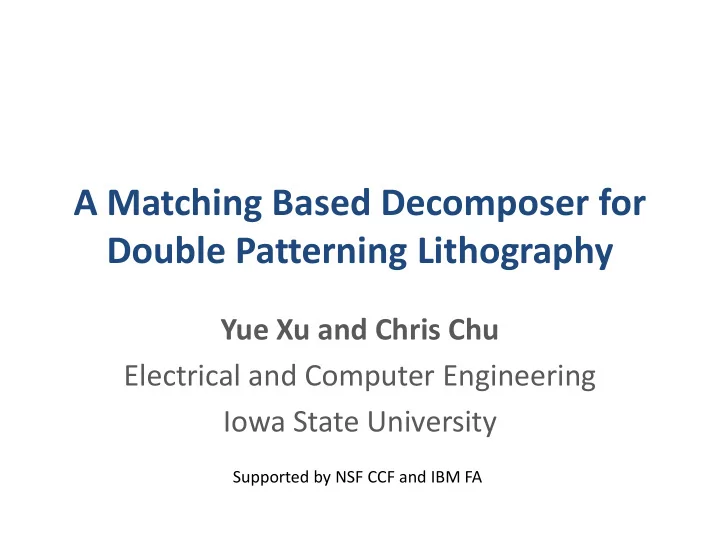

A Matching Based Decomposer for Double Patterning Lithography Yue Xu and Chris Chu Electrical and Computer Engineering Iowa State University Supported by NSF CCF and IBM FA
Outline • Problem Formulation • Previous Work • Algorithm Flow • Planar Graph Proof • Face Merging Based Formulation • Decomposition Algorithm • Experiment 2
Double Patterning Lithography • Double Patterning: Traditional B A C two masks DPL Lithography B C Conflicting • DPL Conflict Mask 1 • DPL Infeasibility: • Stitches Double B Not DPL A C B C Patterning Conflicting Mask 2 3
Double Patterning Lithography • Intrinsic Infeasibility • Layout Modification Mask 1 4
DPL Decomposition Problem • Objective: To assign patterns on one layer to two masks and resolve every non-intrinsic infeasibility with minimum number of stitches ? 5
Recent Decomposers • Model Based Decomposer: – optical simulation – too slow for current complex and large-scale layout • Rule Based Decomposer: – Heuristics that greedily slice and assign patterns – Pre-slice patterns and use ILP to select mask assignment for sliced patterns, Kahng ICCAD 2008, Yuan ISPD 2009 6
Algorithm Flow Ws Ws o o We o We We e Ws We o Ws o We We o Ws Ws Minimum Perfect Matching Pairing Cost Graph Conflict Graph Odd Node Pairing Face Graph Face Node 7
Outline • Problem Formulation • Previous Work • Flow • Planar Graph Proof • Face Merging Based Formulation • Decomposition Algorithm • Experiment 8
Conflict Graph
Planarity Of Conflict Graph • Lemma 1: Crossing does not exist Manhattan Distance: DPL Threshold 2 Min Spacing Euclidian Distance: DPL Threshold Min Spacing 10
Proof for Lemma 1 A C B D 11
Planar Embedding CG Node Auxiliary Node Conflict Edge Auxiliary Edge 12
Outline • Problem Formulation • Previous Work • Flow • Planar Graph Proof • Face Merging Based Formulation • Decomposition Algorithm • Experiment 13
Node Splitting Layout Stitch Generation CG 14
Edge Removal Layout Conflict Elimination CG 15
Face Graph and Pairing 16
Outline • Problem Formulation • Previous Work • Flow • Planar Graph Proof • Face Merging Based Formulation • Decomposition Algorithm • Experiment 17
Face Graph Partition e o o o o/e: o Face Node Polarity o e o 18
SubFG Simplification • Only odd face need to be paired • Use Floyd-Washall algorithm to find the shortest path for each pair of odd nodes • Create a complete graph called Pairing Cost Graph (PCG) e o o o o 19
Matching Based Solution • The odd vertex pairing in the simplified SubFG is minimum weighted perfect matching problem • Convert the minimum weighted perfect matching problem by changing edge weight into a maximum weighted matching problem
Dependent Stitch Layout Pattern A B DPL Conflict γ α β Candidate Stitch Stitch Shield
Contributions • Prove that Conflict Graph is planar • Create Face Graph to model two face merging operations • Propose a new framework for optimal DPL decomposition • Reduce odd-node pairing problem in the entire FG into a set of sub-problems • Transform the pairing problem into minimum weighted matching problem • Use an polynomial runtime maximum weighted matching to solve the minimum weighted matching 22
Experiment Setup and Result • Coded in C • Simulation is run on a 2.8GHz Intel Linux machine with 32GB RAM Matching Based Kahng’s Decomposer Design # Stitch # ER CPU (s) # Stitches # ER CPU (s) AES 31 0 4.9 33 0 17.2 TOP-B 11036 652 45.1 14072 800 448.1 TOP-C 68372 3711 214.3 69490 4000 6629 TOP-D 26917 1395 105.8 27908 1600 1228 Comparison 1 1 1 1.05 1.11 23.7 23
Conclusion and Future Work • Conflict Graph is Planar • Matching Based Decomposer • Optimal and Polynomial Complexity • Extend the face merging formulation to simultaneously solve DPL decomposition and layout modification 24
Recommend
More recommend